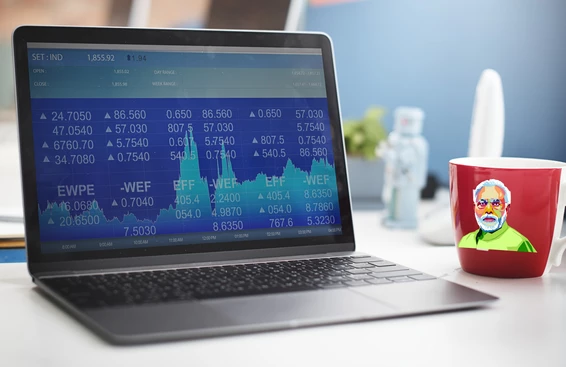This Article was originally published in The Global Analyst
Indian stock market celebrated in style the Modi win. Benchmark indices are up nearly 7% (pre and post poll) while the index is up 9.3% for the year so far, far better than MSCI Emerging Market Index which is up 2.2%. Can this euphoria be sustained? What is the short-term and long-term outlook for the Indian market?
It is indeed tempting to connect the market performance to election results. A resounding pro-incumbency vote much larger than the earlier term does signal enormous confidence in Narendra Modi as a leader who can pursue reforms without fear or favor. However, it is not advisable to link election results to market performance. Election results since 1979 have produced governments that lasted only 13 days (Vajpayee) to 10 years (Manmohan Singh) and hence they may not be comparable. The best market performance happened during V.P. Singh’s tenure that lasted 11 months where Sensex soared 73%! While the worst performance happened during I.K. Gujral’s government that lasted 10 months and Sensex moved only by 1.3%. Hence, I wouldn’t dare to connect the two dots.
After the election dust settles down, the focus will turn to real issues including earnings. While in the short-term markets will react to events like elections, in the medium to long term, markets will react only to earnings growth. Therefore, it will be worthwhile to take a closer look on this key aspect.

Source: NSE India, Economic Times, Reuters
It can clearly be seen that market performance closely correlates to earnings growth. A visual inspection of the graph clearly shows four periods of earnings growth. The 1998-2003 period is the weakest of all with tepid earnings growth and negative market performance. The 2004-2008 period was the best producing an earnings growth of 21% and market growth of nearly 28% annualized. However, the recent two periods witnessed moderate earnings growth of less than 10% while market performance seems to have ran ahead of earnings growth resulting in expensive valuation. Nifty currently trades at a price to earnings ratio of 23 with some sectors like consumer staples trading at a p/e ratio of 60 while energy trades at 16.

For the market to deliver superior returns, EPS growth should mean revert to the earlier levels of 20%+ from the subdued levels today. Forecasts by leading investment banks do point to expectations of 25% to 30% growth in earnings for 2019/2020. Such optimistic forecasts can stem from the low base effect. Given the current EPS of approximately Rs.500 and a p/e ratio of 23 yields a Nifty fair value of about 11,500 while the current Nifty is at a touching distance of 12,000. Hence, further upside to Nifty is predicated either on a EPS growth at say 20% or 25% or a rerating of the valuation from the current p/e of 23 to say 25 or 26.
So the question turns back to “What it will take to clock an earnings growth of 20 to 25%?
There are several challenges that should be overcome to get there and I will flag three of them. Let us start with capex. Companies have held back on capex due to overcapacity, lack of demand, and economic uncertainty including slower growth, increasing deficits and demonetization. The growing fiscal deficit will limit government’s ability to direct money towards capex (including infrastructure) as most of the government expenditure are fixed in nature leading to inflexibility. While expense control is limited, the other way is to increase revenues either through higher taxation (retrograde step) or privatization (poor past track record) or borrowings. The last option seems to be most feasible.
The second aspect will be the growing non-performing assets in the banking system and lack of credible ideas to solve them. Various methods including mergers of state owned banks with their subsidiaries (SBI) have yielded very little results. Recapitalization of banks can be a solution, albeit a costly one though. This “can” of NPA’s has been kicked around for many decades now and hence overnight solution cannot be found to this problem. The nexus between banks, industrialists and the government is too hard to break. However, unless we take this beast head on and treat it, banks will not start to lend again. Indian banks rank as one of the highest NPA’s in the world and this can be a bad news for foreign investors. Hopefully the new government will show some girth and creativity to solve this long ailing problem of Indian business.
And finally the trade war between China and US. It is still not clear how this will directly impact India. If the trade war gets out of hand pulling down the US market, obviously this will be a huge negative for all emerging markets including India. However, there is also a view that among emerging markets, China will obviously be impacted while other competing export economies like Vietnam and South Korea can benefit by grabbing the market share ceded by China. Unfortunately, India not being an export economy cannot grab this great opportunity. Hence, either India will get impacted by the ensuing trade war or it can go unhurt.
In conclusion I should say that in the short-term markets will be positive on the back of the strong euphoria thanks to the resounding victory of Narendra Modi. The long term story of India is intact and attractive and it is not dependent on events like elections. If you are the type that systematically invests in the market and not worry about short term volatility, Indian market offers one of the best risk adjusted return opportunity of a life time. However, if you are the type that would like to time the market and take advantage of events, good luck!
Happy Investing!
